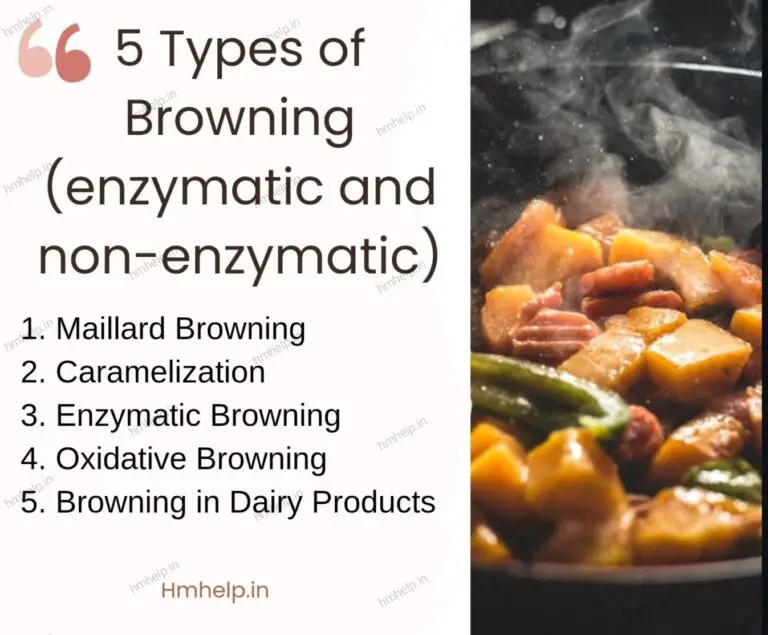
Introduction
Browning is an essential aspect of cooking, as it adds a depth of flavor and visual appeal to dishes. When we cook food, something magical happens – it transforms. One of the most fascinating transformations is browning. It’s not just about changing color; it’s about enhancing flavors and creating that delicious aroma we all love. There are several types of browning that can be achieved in the kitchen, each with its own unique characteristics. In this post of Hmhelp.in, we will be discussing the different types of browning and how to achieve them for the perfect dish.

Types of Browning
1. Enzymatic Browning
Enzymatic browning is a natural chemical reaction that occurs in certain fruits and vegetables when they are cut or bruised and exposed to oxygen in the air. This process is driven by enzymes, which are proteins that act as catalysts, speeding up chemical reactions.
enzymatic browning doesn’t necessarily mean the food is spoiled or unsafe to eat. While it may affect the appearance of the food and lead to some loss of texture and flavor, enzymatic browning generally doesn’t impact the nutritional value or safety of the food.
2. Non Enzymatic Browning
Non-enzymatic browning, also known as chemical browning, is a reaction that occurs in foods without the involvement of enzymes. Unlike enzymatic browning, which is driven by specific proteins called enzymes, non-enzymatic browning is primarily caused by heat and the chemical interactions between sugars and amino acids in food.
3. Maillard reaction
Named after the French chemist Louis-Camille Maillard. The Maillard reaction is a chemical reaction between amino acids and reducing sugars that results in the browning of food. This type of browning is typically associated with meats, as it occurs at high temperatures. The Maillard reaction is responsible for the delicious crust on a steak, the golden-brown color of fried chicken, and the complex flavors in bread crust.
Process to achieve Maillard Reaction browning:
- Use high heat: The Maillard reaction occurs at temperatures above 300 degrees Fahrenheit, so it’s important to use high heat when trying to achieve this type of browning.
- Use a dry surface: The Maillard reaction requires a dry surface, so be sure to pat your meats dry before cooking them.
- Use a small amount of oil: A small amount of oil can help to achieve the Maillard reaction, as it helps to create a barrier that keeps the moisture in the meat while allowing the surface to dry out.
4. Caramelization
Caramelization is the process of heating sugar until it turns brown and develops a complex flavor. This type of browning is typically associated with sweets, such as caramel cand and creme brulee. Caramelization can also be achieved on vegetables, such as caramelized onions or roasted Brussels sprouts. Adds sweetness and depth to dishes, creating a pleasant contrast to savory flavors.
Process to Achieve Caramelization Browning:
- Use high heat: Caramelization occurs at high temperatures, so be sure to use a high heat when trying to achieve this type of browning.
- Use sugar: Caramelization requires sugar, so be sure to add sugar to the dish you’re trying to caramelize.
- Stir occasionally: Caramelization can be uneven, so be sure to stir the dish occasionally to ensure that the sugar is consistent.
5. Oxidative Browning
This occurs when compounds containing phenols, such as tannins in tea or polyphenols in fruits, react with oxygen. Commonly observed in foods like tea, coffee, and certain fruits like apples and bananas when bruised or cut. Can result in changes in flavor and color, sometimes leading to bitterness or astringe
6. Browning in Dairy Products
Dairy products like milk and butter can also undergo browning reactions when exposed to heat. This type of browning can result in the development of flavors like caramel or butterscotch in dishes like custards and sauces. Adds richness and complexity to dishes, elevating their taste and aroma.
Different Methods of Browning:
There are several techniques for browning food, including:
- Sautéing: This involves cooking food quickly in a small amount of oil over high heat. This method is often used for meats, vegetables, and small pieces of food.
- Pan-frying: Similar to sautéing, but with a slightly larger amount of oil and a slightly lower heat. This method is often used for larger cuts of meat or fish.
- Stir-frying: This method involves cooking food quickly in a wok or large pan over high heat, while constantly stirring. This method is often used for vegetables and meats.
- Grilling: This method involves cooking food over an open flame, such as on a grill or barbecue. This method is often used for meats, fish, and vegetables.
- Broiling: This method involves cooking food under a direct heat source, such as an oven broiler. This method is often used for meats, fish, and vegetables.
- Roasting: This method involves cooking food in the oven, often with added fat or oil, until it is browned and crispy on the outside. This method is often used for meats, poultry, and root vegetables.
- Also Check Aims and objectives of cooking
Browning is not just a visual change in food; it’s a complex chemical reaction that enhances flavors, aromas, and textures. Understanding the different types of browning can help us become better cooks, allowing us to manipulate these reactions to create dishes that are not only visually appealing but also bursting with flavor. So, the next time you’re in the kitchen, pay attention to the magic of browning happening right before your eyes!